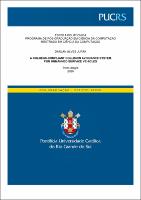| Share record |


|
Please use this identifier to cite or link to this item:
https://tede2.pucrs.br/tede2/handle/tede/9471| Document type: | Dissertação |
| Title: | A COLREGS-compliant collision avoidance system for unmanned surface vehicles |
| Other Titles: | Um sistema de evasão de colisão com respeito à COLREGS para veículos não-tripulados que navegam na superfície da água |
| Author: | Jurak, Darlan Alves  |
| Advisor: | Amory, Alexandre de Morais |
| First advisor-co: | Jorge, Vitor Augusto Machado |
| Abstract (native): | Os veículos de superfície não tripulados (USVs) constituem uma categoria de robôs aquáticos que atuam sem tripulação na superfície da água, apresentando comportamento autônomo ou sendo controlados remotamente. Nas últimas décadas, vários estudos foram realizados para tornar os USVs autônomos. As atuais aplicações de USVs incluem monitoramento do ambiente, exploração de recursos oceânicos como petróleo e gás, vigilância portuária e costeira para fins militares, transporte e pesquisa científica. O Regulamento Internacional para evitar Abalroamento no Mar (RIPEAM) determina regras que devem ser seguidas por marinheiros para evitar colisões em possíveis cenários de colisão, como cruzamento, encontro frontal e ultrapassagem. Atualmente, colisões diretas entre navios representam 60% dos acidentes no mar, e 56% das colisões são causadas por violação do RIPEAM. Portanto, os USVs devem estar em conformidade com o RIPEAM. Nesta dissertação, apresentamos o sistema que desenvolvemos para orientar USVs em missões autônomas e em conformidade com o RIPEAM. O principal módulo de orientação do nosso sistema é um planejador de caminhos que respeita o RIPEAM. Adaptamos a técnica de Artificial Terrain Cost, apresentado por Agrawal [3] et al., à nossa solução baseada em A*, dessa forma, bloqueamos no espaço de busca as posições não compatível com o RIPEAM, através da criação de obstáculos virtuais. Desenvolvemos o nosso sistema usando o ROS (Robotic Operating System) e integramos ele a um barco diferencial disponível no simulador USV_sim, um simulador para USVs, capaz de gerar distúrbios realistas, como vento e corrente de água. Para a avaliar o sistema proposto, medimos o tempo computacional, o vento máximo sustentado e a distância mínima mantida ao encontrar outra embarcação nos cenários de encontro frontal, de cruzamento pela esquerda, cruzamento pela direita e ultrapassagem. |
| Abstract (english): | Unmanned surface vehicles (USVs) are a category of aquatic robots that act unmanned on the water surface, performing autonomous behavior or being remotely controlled. In recent decades, several studies have been carried out to make USVs autonomous. The main challenges are related to collision avoidance, accurate navigation on the high seas, and compliance with international maritime rules, such as the Convention on the International Regulations for Preventing Collisions at Sea (COLREGS). Current applications of USVs include monitoring the environment, exploiting ocean resources such as oil and gas, port and coastal surveillance for military purposes, transport, and scientific research. COLREGS determines rules that must be followed by sailors to avoid collisions in possible collision scenarios, such as crossing, head-on, and overtaking. Currently, direct collisions between vessels represent 60% of accidents at sea, and the violation of COLREGS causes 56% of collisions. Therefore, USVs must comply with COLREGS. In this master’s thesis, we present the system we developed to guide USVs on autonomous missions while following the COLREGS. The main guidance module of our system is a path planner that follows the COLREGS. We adapted the Artificial Terrain Cost method, presented by Agrawal [3] et al., to our solution, blocking locations in the search space that are not compliant with COLREGS, through the creation of virtual obstacles. We integrated our system to a differential boat available in the USV_sim simulator, a simulator for USVs, capable of generating realistic disturbances, such as wind and water current. To evaluate the proposed system, we measure the computational time, the maximum sustained wind, and the minimum distance maintained when encountering another vessel in the scenarios of head-on, crossing from the left, crossing from the right, and overtaking encounters. |
| Keywords: | Unmanned Surface Vehicle (USV) Convention on the International Regulations for Preventing Collisions at Sea Collision Avoidance (COLREGS) Artificial Terrain Cost A* Robotic Operating System (ROS) Normas da Autoridade Marítima (NORMAM) Evasão de colisão |
| CNPQ Knowledge Areas: | CIENCIA DA COMPUTACAO::TEORIA DA COMPUTACAO |
| Language: | eng |
| Country: | Brasil |
| Publisher: | Pontifícia Universidade Católica do Rio Grande do Sul |
| Institution Acronym: | PUCRS |
| Department: | Escola Politécnica |
| Program: | Programa de Pós-Graduação em Ciência da Computação |
| Access type: | Acesso Aberto |
| Fulltext access restriction: | Trabalho não apresenta restrição para publicação |
| URI: | http://tede2.pucrs.br/tede2/handle/tede/9471 |
| Issue Date: | 27-Mar-2020 |
| Appears in Collections: | Programa de Pós-Graduação em Ciência da Computação |
Files in This Item:
| File | Description | Size | Format | |
|---|---|---|---|---|
| DARLAN ALVES JURAK_DIS.pdf | DARLAN_ALVES_JURAK_DIS | 7.65 MB | Adobe PDF |  Download/Open Preview |
Items in DSpace are protected by copyright, with all rights reserved, unless otherwise indicated.




